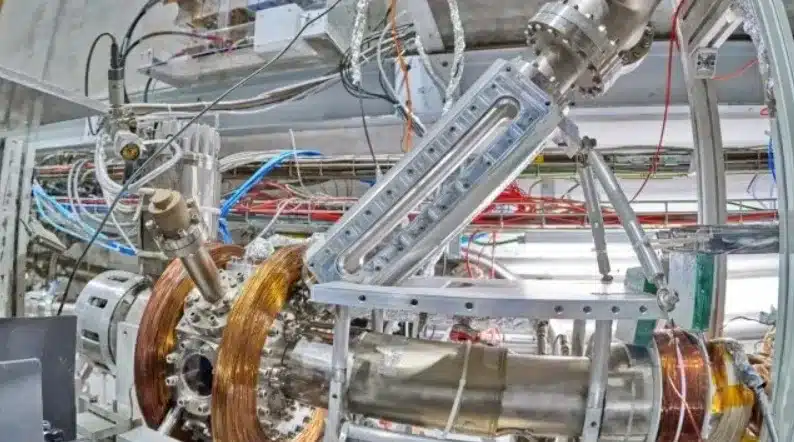What’s in today’s article?
- Why in news?
- What is CERN?
- What is Antihydrogen Experiment: Gravity, Interferometry, Spectroscopy (AEgIS)?
- What is Positronium?
- News Summary: CERN scientists carry out laser cooling of Positronium
- Potential benefits of the experiment
Why in news?
- In a major scientific breakthrough, an international team of researchers has successfully demonstrated laser cooling of Positronium for the first time.
- The breakthrough experiment was carried out by the Antihydrogen Experiment: Gravity, Interferometry, Spectroscopy (AEgIS) collaboration at the European Organization for Nuclear Research (CERN).
CERN
- The name CERN is derived from the acronym for the French “Conseil Européen pour la Recherche Nucléaire”, or European Council for Nuclear Research.
- About
- CERN was founded in 1954 with the mandate of establishing a world-class fundamental physics research organization in Europe.
- CERN is a scientific research organization that studies fundamental physics.
- It operates the world’s largest particle physics laboratory.
- Function
- At CERN physicists and engineers are probing the fundamental structure of the universe.
- They use the world’s largest and most complex scientific instruments to study the basic constituents of matter – the fundamental particles.
- The particles are made to collide together at close to the speed of light.
- The process gives the physicists clues about how the particles interact, and provides insights into the fundamental laws of nature.
- Location
- CERN is located on the Franco-Swiss border near Geneva, Switzerland.
- Members
- Now CERN has 22 members.
- India became an Associate Member State of CERN in 2016.
- India was inducted as an Observer at CERN in 2004.
- Now CERN has 22 members.
Antihydrogen Experiment: Gravity, Interferometry, Spectroscopy (AEgIS)
- About
- AEgIS is an experiment at CERN that studies the effects of gravity on antimatter.
- The experiment’s primary goal is to directly measure the gravitational acceleration of Earth on antihydrogen.
- Antihydrogen is the antimatter counterpart to hydrogen.
- A hydrogen atom is made up of a positively charged proton and a negatively charged electron.
- An antihydrogen atom is made up of a negatively charged antiproton and a positively charged positron.
- It is a collaboration between physicists from Europe and India.
- The experiment is designed to help explain the matter-antimatter asymmetry in the visible universe.
- Antimatter is stable as long as it doesn’t come into contact with matter.
- However, it only lasts a fraction of a second on Earth without special precautions.
- Location
- The experiment is located at the Antiproton Decelerator facility at CERN.
- Achievement
- In 2018, AEgIS became the first in the world to demonstrate the pulsed production of antihydrogen atoms.
Positronium
- Positronium, comprising a bound electron (e-) and positron (e+), is a fundamental atomic system.
- The matter, which forms the world around us, consists of atoms, the simplest of which is hydrogen.
- This is made up of a positively-charged proton and a negatively-charged electron.
- Positronium, on the other hand, consists of an electron and its antimatter equivalent, a positron.
- It was first detected by scientists in the US in 1951.
- Due to its very short life, it annihilates with a half-life of 142 nano-seconds.
- Its mass is twice the electron mass and enjoys the unique distinction of being a pure leptonic atom.
- This hydrogen-like system, with halved frequencies for excitation, makes it a great contender for attempting laser cooling and thereby performing tests of fundamental theories in physics.
- Cooling the Positronium slows the atoms down, making it easier for scientists to study.
News Summary
- In a first, an international team of physicists from the AEgIS collaboration has achieved a breakthrough by demonstrating the laser cooling of Positronium.
- The results show that the researchers were able to cool Positronium atoms from about 380 Kelvin to 170 Kelvin using a specialised laser system.
Potential benefits of the experiment
- This experiment will pave the way for performing spectroscopic comparisons required for the Quantum Electrodynamics (QED).
- QED is the study of the light and its interaction with charged matter.
- The new scientific development will allow high-precision measurements of the properties and gravitational behaviour of matter–antimatter system, which could reveal newer physics.
- It also allows the production of a positronium Bose–Einstein condensate (BEC), in which all constituents occupy the same quantum state.
- A BEC is a state of matter that occurs when particles are cooled to near absolute zero and coalesce into a single quantum object.
- Such a condensate could be used to generate coherent gamma-ray light through the annihilation of matter and antimatter constituents.
- This light would be similar to laser light, consisting of monochromatic waves with a constant phase difference between them.
Q1) What is Quantum electrodynamics (QED)?
Quantum electrodynamics (QED) is a relativistic quantum field theory that describes how light and matter interact. It describes how charged particles interact with the electromagnetic field and mathematically describes all interactions of light with matter and charged particles with one another.
Q2) What is Spectroscopy?
Spectroscopy is the study of how matter absorbs and emits light and other radiation. It involves splitting light into its constituent wavelengths, similar to how a prism splits light into a rainbow.
Source: In a first, CERN scientists carry out laser cooling of Positronium | CERN | CERN – AEgIS | Times of India
Last updated on November, 2025
→ Check out the latest UPSC Syllabus 2026 here.
→ Join Vajiram & Ravi’s Interview Guidance Programme for expert help to crack your final UPSC stage.
→ UPSC Mains Result 2025 is now out.
→ UPSC Notification 2026 is scheduled to be released on January 14, 2026.
→ UPSC Calendar 2026 is released on 15th May, 2025.
→ The UPSC Vacancy 2025 were released 1129, out of which 979 were for UPSC CSE and remaining 150 are for UPSC IFoS.
→ UPSC Prelims 2026 will be conducted on 24th May, 2026 & UPSC Mains 2026 will be conducted on 21st August 2026.
→ The UPSC Selection Process is of 3 stages-Prelims, Mains and Interview.
→ UPSC Result 2024 is released with latest UPSC Marksheet 2024. Check Now!
→ UPSC Prelims Result 2025 is out now for the CSE held on 25 May 2025.
→ UPSC Toppers List 2024 is released now. Shakti Dubey is UPSC AIR 1 2024 Topper.
→ UPSC Prelims Question Paper 2025 and Unofficial Prelims Answer Key 2025 are available now.
→ UPSC Mains Question Paper 2025 is out for Essay, GS 1, 2, 3 & GS 4.
→ UPSC Mains Indian Language Question Paper 2025 is now out.
→ UPSC Mains Optional Question Paper 2025 is now out.
→ Also check Best IAS Coaching in Delhi

















